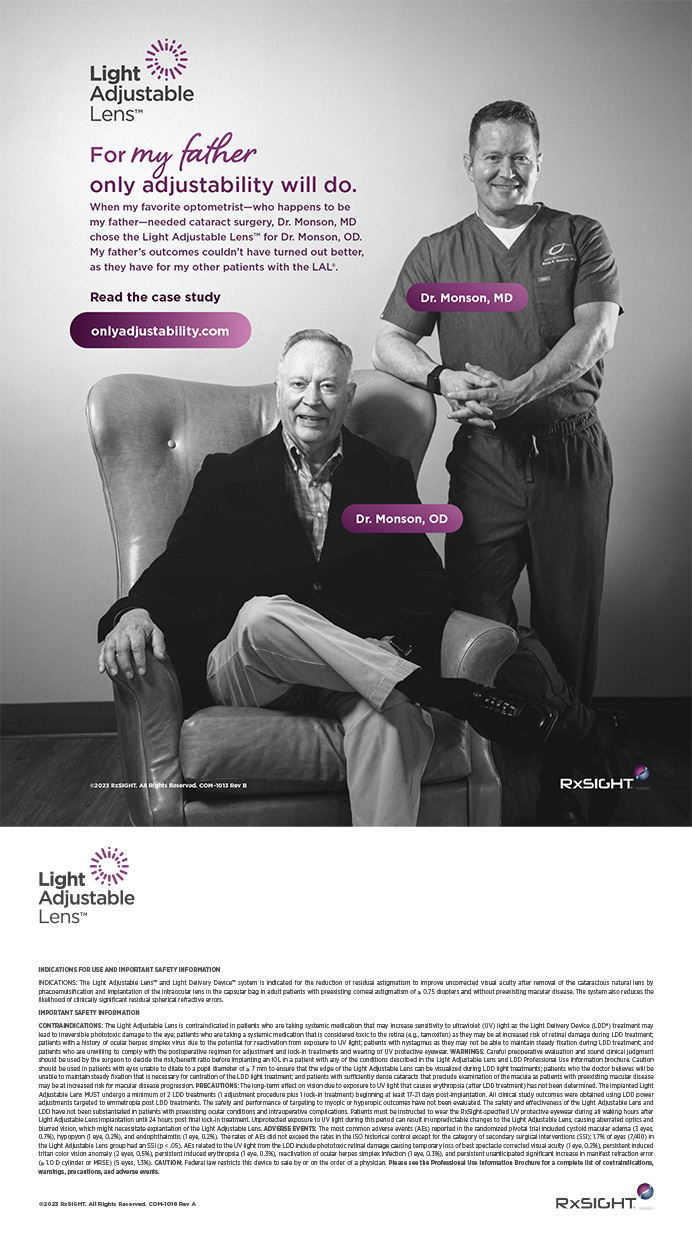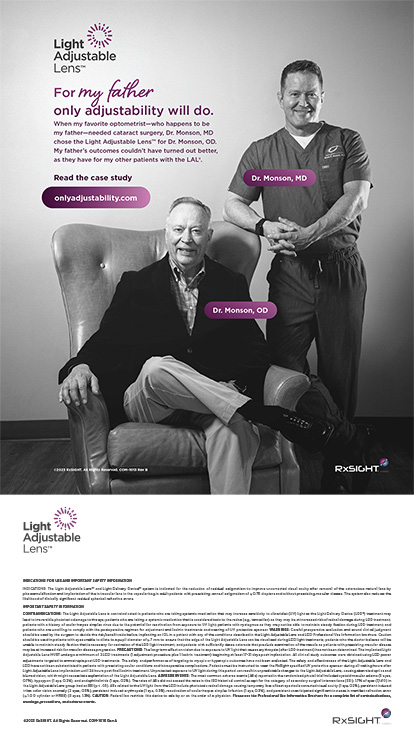CASE PRESENTATION
Four months postoperatively, a patient emphatically describes a dark crescent off to the side in the oper- ated eye. The patient says that the symptom has been present since surgery and has only improved margin- ally. The appointment was made specifically to discuss this issue. What is your recommended management strategy?
—Topic prepared by Steven Dewey, MD.
JAMES A. DAVISON, MD
Patients typically perceive pseudophakic negative dysphotopsia (ND) as a dark shadow in their temporal field of vision. Although usually a minor and transient observation, symptoms can vary greatly in character and persistence. ND was first described in patients who received square-edged acrylic IOLs and appeared to have perfect anatomic results, including complete anterior capsular overlap of the IOL’s peripheral optic.1 ND has since been noted to occur in patients who have received other types of IOLs.
The cause of ND has been thought to be a shadow effect created by the edge of the IOL’s optic.1,2 Another theory is that ND may relate to the anterior capsule’s overlap of the anterior IOL optic.3 Some report resolving ND by prolapsing the optic anterior to the anterior capsule (reverse optic capture) or by creating an obscuration of the anterior capsule-anterior optic interface through implantation of a piggyback plano-powered IOL in the ciliary sulcus.3 My personal results with these measures, however, have varied. Nasal anterior capsulectomy with the Nd:YAG laser resolved symptoms in one case involving a STAAR plate haptic silicone IOL (STAAR Surgical)4 and was somewhat successful in five cases involving the Akreos AO MI60L (Bausch + Lomb) but not in one case with an AcrySof single-piece IOL (Alcon).5 In my one case with an AcrySof single-piece IOL, 360° radial anterior capsulotomies were completely ineffective (Figure 1).6
The patient in this case has had unrelenting, severe symptoms for 4 months, so I would plan an IOL exchange using a STAAR AQ5010V IOL (STAAR Surgical). This lens features a 6.3-mm, round-edged silicone optic. It is 14 mm long with 10º posterior angulation. A reverse optic capture strategy could also be used to further increase the chance of completely resolving ND. A piggyback IOL placed in the sulcus might abrade the iris’ posterior pigment, causing pigment dispersion (Figure 2), so the IOP would need to be monitored if that strategy were used. I would counsel the patient that any surgical strategy may be ineffective and that the masking effect created by framed spectacles could be required to manage the symptoms.
GREGORY S. H. OGAWA, MD
My first step in the management of a case like this one is to determine the cause of the symptom through the patient’s history and an examination. If the examination is essentially normal and the patient has a square-edged acrylic IOL, then it is very likely that he or she is noticing ND. I would ask the patient if the shadow is just noticeable or if it is actually bothersome. If it is bothersome, I would ascertain the degree to which it bothers the patient. I would explain to the patient the cause of the symptom and the treatment options, which range from observation to additional surgery with its associated risks. Although a temporal ND rarely resolves after 4 months postoperatively, a substantial percentage of patients will either become less bothered by it, or they will decide that they would rather tolerate the shadow than undergo additional surgery. A small percentage of patients elect to have another surgery, even after additional time trying to adapt to the shadow.
My surgical treatment of choice is an IOL exchange with placement of a silicone IOL in the capsular bag or, if not possible, in the sulcus. For sulcus placement, I use the STAAR AQ2010V IOL (STAAR Surgical), which was recommended for use in the sulcus by the American Society of Cataract and Refractive Surgery Cataract Clinical Committee. I use this lens during the exchange, even for bag placement, because at our practice, this lens exhibits a very low rate of dysphotopsia. The surgeons at Eye Associates of New Mexico have found this surgical modality to be uniformly successful at treating ND.
LARRY PATTERSON, MD
This patient is describing ND, a condition in which the absence of vision is noted. ND is believed to be an interaction between the incoming light rays at the IOL’s edge. Patients most commonly notice a dark crescent temporally after surgery, relatively independent of the ambient lighting. Reactions range from slight annoyance to extreme unhappiness, sometimes with demands that the IOL be removed. In time, many patients notice the symptoms less, sometimes achieving complete resolution. Whether this is due to neuroadaptation or simple “neuroresignation” is unclear. Usually, the IOL is centered in the capsular bag with good anterior capsular overlap. Although ND has been reported with nearly every IOL style and material, it is most commonly seen with square-edged IOLs that have high indices of refraction such as acrylic lenses.
Patients should be encouraged that symptoms may very well resolve with time. In this case, with minimal improvement after 4 months, treatment is indicated. The solution usually is reverse optic capture, whereby the surgeon gently dissects the anterior capsule off the surface of the optic and prolapses the optic anterior to the anterior capsule, leaving the haptics in the bag. I can only describe treatment anecdotally. For nearly 2 decades, a three-piece silicone IOL has been my “go to” lens. After implanting about 15,000 of these, I have yet to have a single patient require treatment for ND.
Section Editor Alan N. Carlson, MD, is a professor of ophthalmology and chief, corneal and refractive surgery, at Duke Eye Center in Durham, North Carolina.
Section Editor Steven Dewey, MD, is in private practice with Colorado Springs Health Partners in Colorado Springs, Colorado. Dr. Dewey may be reached at (719) 475-7700; sdewey@cshp.net.
Section Editor R. Bruce Wallace III, MD, is the medical director of Wallace Eye Surgery in Alexandria, Louisiana. Dr. Wallace is also a clinical professor of ophthalmology at the Louisiana State University School of Medicine and at the Tulane School of Medicine, both located in New Orleans.
James A. Davison, MD, is a cataract and refractive surgeon at Wolfe Eye Clinic in Marshalltown and West Des Moines, Iowa. He is a consultant to Alcon. Dr. Davison may be reached at jdavison@wolfeclinic.com.
Gregory S. H. Ogawa, MD, practices at Eye Associates of New Mexico in Albuquerque. He acknowledged no financial interest in the products or companies he mentioned. Dr. Ogawa may be reached at (505) 888-5757; gogawa@eyenm.com.
Larry Patterson, MD, is a cataract and refractive surgeon at Eye Centers of Tennessee in Crossville. Dr. Patterson may be reached at larryp@ecotn.com.
- Davison JA. Positive and negative dysphotopsia in patients with acrylic intraocular lenses. J Cataract Refract Surg. 2000;26:1346-1355.
- Holladay JT, Zhao H, Reisin CR. Negative dysphotopsia: the enigmatic penumbra. J Cataract Refract Surg. 2012;38:1251-1265.
- Masket S, Fram NR. Pseudophakic negative dysphotopsia: surgical management and a new theory of etiology. J Cataract Refract Surg. 2011;37:1199-1207.
- Cooke DL, Kasko S, Platt LO. Resolution of negative dysphotopsia after laser anterior capsulotomy. J Cataract Refract Surg. 2013;39:1107-1109.
- Folden DV. Neodymium:YAG laser anterior capsulectomy: surgical option in the management of negative dysphotopsia. J Cataract Refract Surg. 2013;39:110-1115.
- Davison JA. Consultation section, cataract surgical problem. J Cataract Refract Surg. 2013;39:1124-1125.


